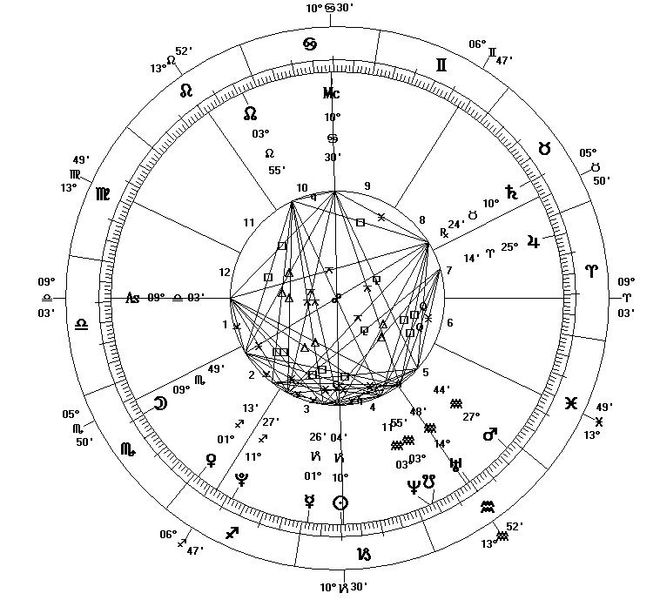|
Hindu astrology (also known as Indian astrology, more recently Vedic astrology, also Jyotish or Jyotisha, from Sanskrit jyotiṣa, from jyótis- "light, heavenly body") is the traditional Hindu system of astronomy and astrology. It has three branches:
Siddhanta: Indian astronomy.
Samhita: Mundane astrology, predicting important events related to countries such as war, earthquakes, political events, financial positions, electional astrology, house and construction related matters (Vāstu Shāstra), animals, portents, omens, and so on.
Hora: Predictive astrology in detail.
foundation of Hindu astrology is the notion of bandhu of the Vedas, (scriptures), which is the connection between the microcosm and the macrocosm. Practice relies primarily on the sidereal zodiac, which is different from the tropical zodiac used in Western (Hellenistic) astrology in that an ayanamsa adjustment is made for the gradual precession of the vernal equinox.
Hindu astrology includes several nuanced sub-systems of interpretation and prediction with elements not found in Hellenistic astrology, such as its system of lunar mansions (nakshatras).
Astrology remains an important facet in the lives of many Hindus.
In Hindu culture, newborns are traditionally named based on their jyotish charts, and astrological concepts are pervasive in the organization of the calendar and holidays as well as in many areas of life, such as in making decisions made about marriage, opening a new business, and moving into a new home. Astrology retains a position among the sciences in modern India.
Following a judgement of the Andhra Pradesh High Court in 2001, some Indian universities offer advanced degrees in astrology.
The term Hindu astrology had been in use as the English equivalent of Jyotisha since the early 19th century.Vedic astrology is a relatively recent term, entering common usage in the 1980s with self-help publications on Ayurveda or Yoga. The qualifier "Vedic" is however a something of a misnomer, as there is no mention of Jyotisha in the Vedas, and historical documentation suggests horoscopic astrology in the Indian subcontinent was a Hellenic influence post-dating the Vedic period.

Jyotiṣa is one of the Vedanga, the six auxiliary disciplines used to support Vedic rituals. Early jyotish is concerned with the preparation of a calendar to fix the date of sacrificial rituals. Nothing is written on planets. There are mentions of eclipse causing "demons" in the Atharaveda and Chandogya Upanishad, the Chandogya mentioning Rahu.
In fact the term graha, which is now taken to mean planet, originally meant demon.The Rgveda also mentions an eclipse causing demon, Svarbhānu, however the specific term of "graha" becomes applied to Svarbhānu in the later Mahabharata and Ramayana.
It is only after the Greek settlement in Bactria (third century BC) that explicit references to planets are attested in Sanskrit texts. It was only after the transmission of Hellenistic astrology that the order of planets in India was fixed in that of the seven-day week.
Hellenstic astrology and astronomy also transmitted the twelve zodiacal signs beginning with Aries and the twelve astrological places beginning with the ascendant. The first evidence of the introduction of Greek astrology to India is the Yavanajataka which dates to the early centuries CE.
The Yavanajataka ("Sayings of the Greeks") was translated from Greek to Sanskrit by Yavanesvara during the 2nd century CE, under the patronage of the Western Satrap Saka king Rudradaman I, and is considered the first Indian astrological treatise in the Sanskrit language.[18] However the only version that survives is the later verse version of Sphujidhvaja which dates to AD 270. The first Indian astronomical text to define the weekday was the Āryabhaṭīya of Āryabhaṭa (born AD 476). According to Michio Yano, Indian astronomers must have been occupied with the task of Indianizing and Sanskritizing Greek astronomy during the 300 or so years between the first Yavanajataka and the Āryabhaṭīya. The astronomical texts of these 300 years are lost. The later Pañcasiddhāntikā of Varāhamihira summarizes the five known Indian astronomical schools of the sixth century.
It is interesting to note that Indian astronomy preserved some of the older pre-Ptolemaic elements of Greek astronomy.
The main texts upon which classical Indian astrology is based are early medieval compilations, notably the Bṛhat Parāśara Horāśāstra, and Sārāvalī by Kalyāṇavarman. The Horashastra is a composite work of 71 chapters, of which the first part (chapters 1–51) dates to the 7th to early 8th centuries and the second part (chapters 52–71) to the later 8th century. The Sārāvalī likewise dates to around 800 CE. English translations of these texts were published by N.N. Krishna Rau and V.B. Choudhari in 1963 and 1961, respectively.
|